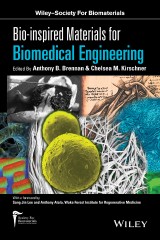Details

Bio-inspired Materials for Biomedical Engineering
Wiley-Society for Biomaterials 1. Aufl.
|
144,99 € |
|
| Verlag: | Wiley |
| Format: | |
| Veröffentl.: | 19.03.2014 |
| ISBN/EAN: | 9781118843628 |
| Sprache: | englisch |
| Anzahl Seiten: | 400 |
DRM-geschütztes eBook, Sie benötigen z.B. Adobe Digital Editions und eine Adobe ID zum Lesen.
Beschreibungen
<p>This book covers the latest bio-inspired materials synthesis techniques and biomedical applications that are advancing the field of tissue engineering. Bio-inspired concepts for biomedical engineering are at the forefront of tissue engineering and regenerative medicine. Scientists, engineers and physicians are working together to replicate the sophisticated hierarchical organization and adaptability found in nature and selected by evolution to recapitulate the cellular microenvironment. This book demonstrates the dramatic clinical breakthroughs that have been made in engineering all four of the major tissue types and modulating the immune system.</p> <p>Part I (Engineering Bio-inspired Material Microenvironments) covers Bio-inspired Presentation of Chemical Cues, Bio-inspired Presentation of Physical Cues, and Bio-inspired Integration of Natural Materials.<br /> <br /> Part II (Bio-inspired Tissue Engineering) addresses tissue engineering in epithelial tissue, muscle tissue, connective tissue, and the immune system.</p>
<p>Contributors vii</p> <p>Preface xi</p> <p>Introduction 1<br /><i>Sang Jin Lee and Anthony Atala</i></p> <p><b>Part I </b><b>Engineering Bio-Inspired Material Microenvironments 5</b></p> <p>Chapter 1 ECM-Inspired Chemical Cues: Biomimetic Molecules and Techniques of Immobilization 7<br /><i>Roger Y. Tam, Shawn C. Owen, and Molly S. Shoichet</i></p> <p>Chapter 2 Dynamic Materials Mimic Developmental and Disease Changes in Tissues 25<br /><i>Matthew G. Ondeck and Adam J. Engler</i></p> <p>Chapter 3 The Role of Mechanical Cues in Regulating Cellular Activities and Guiding Tissue Development 45<br /><i>Liming Bian</i></p> <p>Chapter 4 Contribution of Physical Forces on the Design of Biomimetic Tissue Substitutes 59<br /><i>Menekse Ermis, Erkan Türker Baran, Tu</i>ğ<i>ba Dursun, Ezgi Antmen, and Vasif Hasirci</i></p> <p>Chapter 5 Cellular Responses to Bio-Inspired Engineered Topography 77<br /><i>Chelsea M. Kirschner, James F. Schumacher, and Anthony B. Brennan</i></p> <p>Chapter 6 Engineering The Mechanical and Growth Factor Signaling Roles of Fibronectin Fibrils 99<br /><i>Christopher A. Lemmon</i></p> <p>Chapter 7 Biologic Scaffolds Composed of Extracellular Matrix as a Natural Material for Wound Healing 111<br /><i>Elizabeth W. Kollar, Christopher L. Dearth, and Stephen F. Badylak</i></p> <p>Chapter 8 Bio-Inspired Integration of Natural Materials 125<br /><i>Albino Martins, Marta Alves da Silva, Ana Costa-Pinto, Rui L. Reis, and Nuno M. Neves</i></p> <p><b>Part II </b><b>Bio-Inspired Tissue Engineering 151</b></p> <p>Chapter 9 Bio-Inspired Design of Skin Replacement Therapies 153<br /><i>Dennis P. Orgill</i></p> <p>Chapter 10 Epithelial Engineering: From Sheets to Branched Tubes 161<br /><i>Hye Young Kim and Celeste M. Nelson</i></p> <p>Chapter 11 A Biomimetic Approach Toward The Fabrication of Epithelial-Like Tissue 175<br /><i>Hongjun Wang and Meng Xu</i></p> <p>Chapter 12 Nano- and Microstructured ECM and Biomimetic Scaffolds for Cardiac Tissue Engineering 195<br /><i>Quentin Jallerat, John M. Szymanski, and Adam W. Feinberg</i></p> <p>Chapter 13 Strategies and Challenges for Bio-Inspired Cardiovascular Biomaterials 227<br /><i>Elaine L. Lee and Joyce Y. Wong</i></p> <p>Chapter 14 Evaluation of Bio-Inspired Materials for Mineralized Tissue Regeneration Using Type I Collagen Reporter Cells 259<br /><i>Liisa T. Kuhn, Emily Jacobs, and A. Jon Goldberg</i></p> <p>Chapter 15 Learning from Tissue Equivalents: Biomechanics and Mechanobiology 281<br /><i>David D. Simon and Jay D. Humphrey</i></p> <p>Chapter 16 Mimicking the Hematopoietic Stem Cell Niche by Biomaterials 309<br /><i>Eike Müller, Michael Ansorge, Carsten Werner, and Tilo Pompe</i></p> <p>Chapter 17 Engineering Immune Responses to Allografts 327<br /><i>Anthony W. Frei and Cherie L. Stabler</i></p> <p>Chapter 18 Immunomimetic Materials 357<br /><i>Jamal S. Lewis and Benjamin G. Keselowsky</i></p> <p>Index 371</p>
<p><b>Anthony B. Brennan</b> is the Margaret A. Ross Endowed Professor of Materials Science and Engineering and a professor of Biomedical Engineering at the University of Florida. He received his Bachelor's degree in chemistry from State University of New York at Potsdam in 1975 and his Ph.D. in Materials Engineering Science from Virginia Polytechnic Institute and Statue University in 1990. Dr. Brennan has been a member of the faculty at the University of Florida since 1991. His materials focus is on the structure of the interphase between the cell and the substrate.</p> <b>Chelsea M. Kirschner</b> obtained a Bachelor's degree in Materials Science and Engineering at the University of Florida in 2006, and her Ph.D. in Biomedical Engineering from the University of Florida in 2010. Dr. Kirschner completed a postdoctoral research fellowship at the University of Colorado at Boulder in 2013. Her research focused on the influence of spatially and temporally patterned hydrogel architectures and chemistries on adult stem cell shape and differentiation. She is currently a Biomedical R&D Engineer at Sharklet Technologies in Aurora, CO.
<p>This book covers the latest bio-inspired materials synthesis techniques and biomedical applications that are advancing the field of tissue engineering. Bio-inspired concepts for biomedical engineering are at the forefront of tissue engineering and regenerative medicine. Scientists, engineers and physicians are working together to replicate the sophisticated hierarchical organization and adaptability found in nature and selected by evolution to recapitulate the cellular microenvironment. This book demonstrates the dramatic clinical breakthroughs that have been made in engineering all four of the major tissue types and modulating the immune system.</p> <p>Part I (Engineering Bio-inspired Material Microenvironments) covers Bio-inspired Presentation of Chemical Cues, Bio-inspired Presentation of Physical Cues, and Bio-inspired Integration of Natural Materials.<br /> <br /> Part II (Bio-inspired Tissue Engineering) addresses tissue engineering in epithelial tissue, muscle tissue, connective tissue, and the immune system.</p>

















